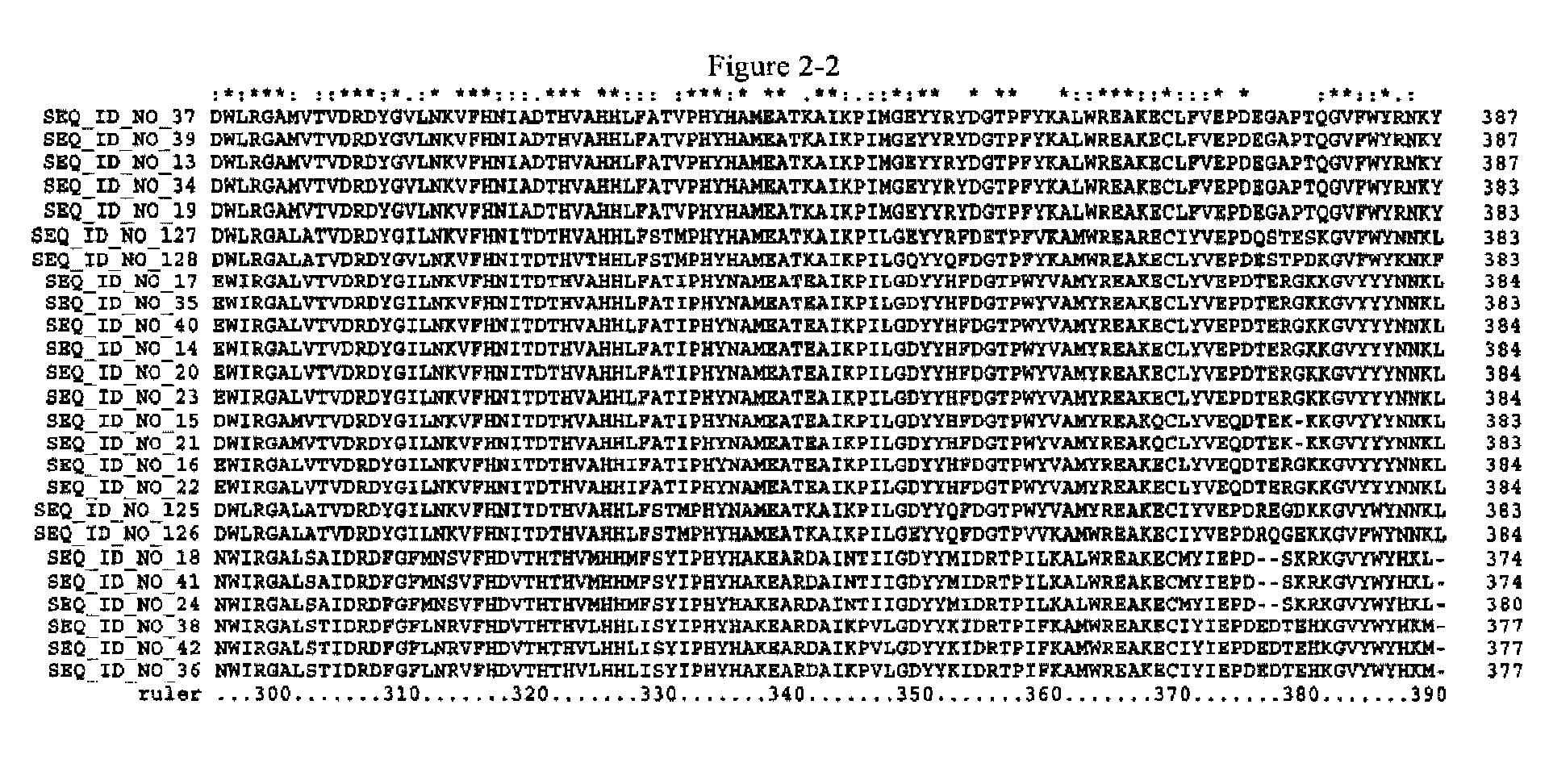Nucleic Acids Encoding Anthelmintic Agents And Plants Made Therefrom
a technology of anthelmintic agents and nucleic acids, applied in the field of plant pathology and plant genetic transformation, can solve the problems of two nematicidal agents that have proven less effective in agricultural applications against root pathogens, significant environmental impact, and strawberry and other commodity crop industries
- Summary
- Abstract
- Description
- Claims
- Application Information
AI Technical Summary
Benefits of technology
Problems solved by technology
Method used
Image
Examples
example 1
RNA Mediated Interference (RNAi)
[0117] A double stranded RNA (dsRNA) molecule can be used to inactivate a delta-12 fatty acid desaturase (delta-12 fat2) gene in a cell by a process known as RNA mediated-interference (Fire et al. (1998) Nature 391:806-811, and Gönczy et al. (2000) Nature 408:331-336). The dsRNA molecule can have the nucleotide sequence of a delta-12 fat2 nucleic acid (preferably exonic) or a fragment thereof. The dsRNA molecule can be delivered to nematodes via direct injection, or by soaking nematodes in aqueous solution containing concentrated dsRNA, or by raising bacteriovorous nematodes on E. coli genetically engineered to produce the dsRNA molecule.
[0118] RNAi by Injection:
[0119] To examine the effect of inhibiting delta-12 fat2 activity, a dsRNA corresponding to the C. elegans delta-12 fat2 gene was injected into the nematode, basically as described in Mello et al. (1991) EMBO J. 10:3959-3970. Briefly, a plasmid was constructed that contains a portion of the...
example 2
Rescue of C. elegans Delta-12 fat2 RNAi Feeding Phenotype by Linoleic Acid Methyl Ester
[0124] The C. elegans delta-12 fatty acid desaturase (FAT-2 protein) converts the mono-unsaturated oleic acid to the di-unsaturated fatty acid linoleic acid. The delta-12 fat2 RNAi prevents expression of the delta-12 fatty acid desaturase, which is predicted to cause a decrease in levels of linoleic acid in the nematode, leading to arrested development and death. Addition of 3 mM linoleic acid methyl ester to the NGM media used for the RNAi experiment brings about a partial rescue of the delta- 12 fat2 RNAi feeding phenotype. Addition of 3 mM oleic acid methyl ester does not rescue the delta-12 fat2 RNAi feeding phenotype (see Table 1 below).
TABLE 1C. elegans delta-12 fat2 RNAi feeding phenotypes (starting withC. elegans L4 larvae as the P0 animal)Fatty AcidAddedP0 phenotypeF1 phenotypeF2 phenotypeNoneReduced egg layingDevelopmentallyNA(partial sterility)arrested andsterileOleic AcidReduced egg...
example 3
Preparation of Caenorhabditis elegans and Fatty Acids
[0125] Mixed stage C. elegans were washed off plates seeded with OP50 bacteria using M9 solution. 250 μl of the M9 solution, which contained about 50-100 worms, was pipetted into each well of a 24-well plate.
[0126] With the exceptions of the fatty acid salts and the free acid of ricinelaidic acid, all other fatty acid emulsions were prepared following the teachings of Kim et al (U.S. Pat. No. 5,698,592). Briefly, 1 mL 1% stock solution emulsions were prepared by mixing 10 μl of fatty acid with 20 μl of the surfactant Igepal CO 630 in a 1.5 mL eppendorf tube. After careful mixing of fatty acid and Igepal CO 630, 850 μl of ddH20 was added and mixed by gentle pipetting until a homogeneous solution was obtained. Finally, 120 μl of pure isopropanol was added and mixed by gentle pipetting. 1% stock emulsions were also prepared for the potassium salt of ricinoleic acid, the sodium salt of ricinelaidic acid, and ricinelaidic free acid. ...
PUM
| Property | Measurement | Unit |
|---|---|---|
| apparent dissociation constant | aaaaa | aaaaa |
| apparent dissociation constant | aaaaa | aaaaa |
| apparent dissociation constant | aaaaa | aaaaa |
Abstract
Description
Claims
Application Information
 Login to View More
Login to View More - R&D
- Intellectual Property
- Life Sciences
- Materials
- Tech Scout
- Unparalleled Data Quality
- Higher Quality Content
- 60% Fewer Hallucinations
Browse by: Latest US Patents, China's latest patents, Technical Efficacy Thesaurus, Application Domain, Technology Topic, Popular Technical Reports.
© 2025 PatSnap. All rights reserved.Legal|Privacy policy|Modern Slavery Act Transparency Statement|Sitemap|About US| Contact US: help@patsnap.com



